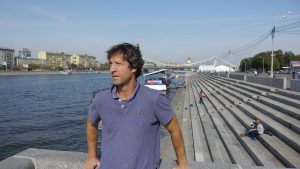Professional dancer uses expertise and experience to help fellow sufferers of Parkinson’s disease
By Sun Staff

When Alex Tressor demonstrates stretches on his website, PDontheMove.com, also found on YouTube, he is not just an instructor—who looks like you wish you did—he is a living example of how to “wrestle the beast.” The beast in this case is Parkinson’s disease.
Diagnosed 12 years ago, when Tressor was 47, this lifelong professional dancer had an unforeseen awakening. If he, as an athlete, could be struck with this incurable disease, given his strength and healthy lifestyle, what must it be like for those who did not have his advantages? Parkinson’s generally strikes people after the age of 60, though 5 to 10 percent of people with PD are victims of early onset, such as Tressor. Men are more likely to be affected than women.
Parkinson’s disease is a neurological condition often referred to as a motor-system disorder. Historians found evidence of the disease as far back as 5,000 B.C. It was first described as “the shaking palsy” in 1817 by British doctor James Parkinson.
Over the course of the past decade, Tressor and his wife, Alexis, a medical student in Boston, grew frustrated with the Western medicine response to PD, which relies on drugs and brain stimulation to treat the disease. In 2017, they started PDontheMove.com, on which they share articles and information, personal programs and consultations, along with nutrition, exercise and lifestyle videos.
The three-pronged approach is nutrition, exercise and stress relief. The slyly witty Tressor—who looks years younger than his age—will speak about his approach at a talk to be held from 11:30 a.m. to 12:30 p.m. Thursday, Oct. 18, at the Limelight Hotel in Ketchum. Tressor is also teaching movement classes for Parkinson’s sufferers at Zenergy Health Club in Sun Valley at 11 a.m. every Tuesday. Both classes are free and open to the public.
In September, Tressor, who was born in Russia and moved to New York City in 1976, relocated to the Wood River Valley to be Sun Valley Ballet’s new director and ballet master. He is working with the SVB’s board to reimagine the school’s headquarters in downtown Hailey as a creative center.
“We can have yoga, meditation and Zumba in the early day and later have ballet school,” Tressor said. “There will be a recital in mid-December where the students will have a chance to sing, act, dance, to exhibit all their talents in one space.”
As they work to reimagine the ballet school’s space and its capabilities for the community, Tressor presses ahead in his work to help people with PD while managing his own health.
“Living with and fighting PD had taught me how to best approach this complex disease,” he said. “The idea with Parkinson’s on the Move is to move it as far away as possible, hopefully to another planet.”
Tressor admits he didn’t know much about the disease before his diagnosis. But he learned quickly through fellow dancer Mark Morris’s organization, Dancing for PD, which has created dance classes in 250 communities throughout the world. As well, he pored over the Michael J. Fox Foundation’s website, which raises money to fund research and expertise. It was clear that being in excellent physical condition put Tressor ahead in his battle, and that is what he seeks to impart in his own work.
“I started after the director of Dancing for PD took one of my ballet classes,” he said. “Then I met with Michael J. Fox at an event at the Waldorf Astoria in New York. I sat next to him and said, ‘If you’re going back to the future, come back with a cure.’”
Experts aren’t sure a cure—they barely have a grasp on the cause—will happen in either Fox’s or Tressor’s lifetimes, but he believes in being ready, nonetheless.
At the Stamford (Conn.) Medical Center, Tressor designed and taught classes for Parkinson’s sufferers and was able to fine-tune how to help people who weren’t fit already.
“For most people, we have to strip everything away and start with a new frame of mind,” he said. “For more than a century, they said you are going to lose strength, balance and muscle tone. You will be reduced to sitting in a chair, then flat on your back. After the bad news, the doctors compound it by laying it out like this.
“We don’t know when we’ll get some help, but we must be in the best shape, and to do that you have to be superhuman, and must not deviate from the plan. You have to have complete devotion to your health. Everything else comes in second. Only then can you live with it.
“Sedentary and stressful lifestyles and bad nutrition—it’s a combination of these three things,” he said. “After 12 years, I know what works. Nutritionally, the biggest thing is sugar. You can go from slight symptoms to being hospitalized after eating just a piece of cake. Most people don’t know where their food comes from or what’s in it. Parkinson’s is stressful enough and the disease doesn’t let you do that. You have to keep an eye on that. If we can wrestle these three things, we can manage it.”
For more information, attend Tressor’s talk on Thursday and visit PDontheMove.com.
